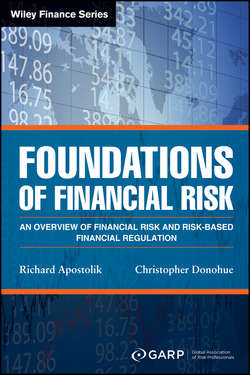Читать книгу Foundations of Financial Risk - Apostolik Richard - Страница 6
На сайте Литреса книга снята с продажи.
Introduction
ОглавлениеThis textbook, previously published in 2009 as the Foundations of Banking Risk has been revised, updated and expanded. GARP has renamed the book to reflect the additional content which includes a new chapter on insurance risk.
The role of risk management is becoming more important as banks, insurance firms, and supervisors around the world recognize that good risk management practices are vital, not only for the success of individual firms, but also for the safety and soundness of the financial system as a whole. As a result, the world's leading supervisors have developed regulations based on a number of "good practice" methodologies used in risk management. The banking regulations, outlined in the International Convergence of Capital Measurement and Capital Standards, known as the Basel Accord, and the insurance regulations, known as Solvency 2, codify such risk management practices.
The importance of these risk management methodologies as a basis for regulation is hard to overstate. The fact that they were developed with the support of the international financial community means that they have gained worldwide acceptance as the standards for risk management.
The implementation of risk-based regulation means that staff, as well as supervisors, will need to be educated and trained to recognize risks and how to implement risk management approaches. Consequently, GARP offers this program, the Foundations of Financial Risk, to provide staff with a basic understanding of banking, banking risks, insurance risks, regulation and supervision. This study text has been designed to assist students in preparing for the Foundations of Financial Risk assessment exam. It is presented in a user-friendly format to enable candidates to understand the key terms and concepts of the industries, and their risks and risk-based regulation.
This study text concentrates on the technical terms used in banking and risk management, while providing an insight to the similar risk in the insurance industry. These terms are defined either in the text or in the glossary. As the material is at the introductory level, candidates are not expected to have a detailed understanding of risk management or significant experience in banking. In this text, they will gain an understanding of the commonly used terms in the finance industry.
Each chapter contains a number of examples of actual financial events, as well as case study scenarios, diagrams, and tables aimed at explaining banking, banking risks, and risk-based regulations. This study text has adopted the standard codes used by banks throughout the world to identify currencies for the purposes of trading, settlement, and displaying of market prices. The codes, set by the International Organization for Standardization (ISO), avoid the confusion that could result as many currencies have similar names. For example, the text uses USD for the U.S. dollar, GBP for the British pound, EUR for the euro, and JPY for the Japanese yen.
